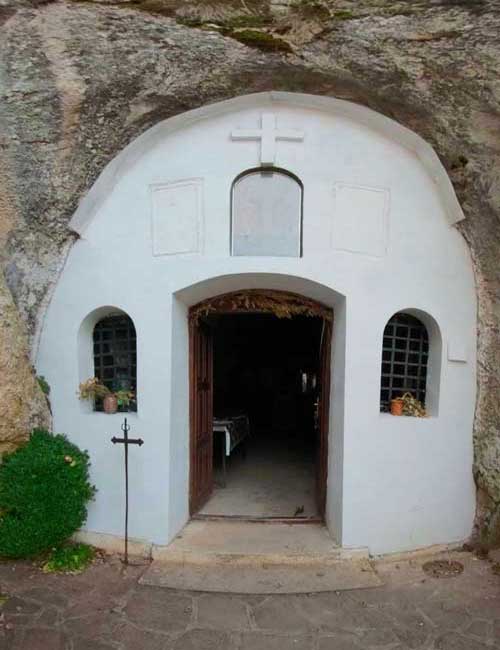The Church of Saint apostles Peter and Paul
Protected cultural monument, listed as SK 769 with the Republic Institute for the protection of monuments of cultural heritage.
The cave church of Saint apostles Peter and Paul Rsovac
Location
The village of Rsovci is located at the foot of Stara planina mountain, on the left bank of the river Visočica, 24 km from the town of Pirot. In the vicinity of the village, at the foot of Kalik hill, there is a very unique church located within a cave, dedicated to the holy apostles Peter and Paul, The Church of Saint apostles Peter and Paul, better known as the “Cave church”.

Description
The natural configuration of the terrain was used to build this church. The rectangular space inside the cave was used for the naos, while the apse was built at the back using limestone ashlars. The frontal, western wall was housed in the opening of the wall, and thus a small church was created, used in the XII and XIII century. The frontal wall is arched in a semi-circle from the upper side, in the middle is the entrance with two side windows, and above the entrance is a niche with the image of saints to whom the church is dedicated. A part of the cave of about 50 square meters is used as a church, while behind the altar space there is the rest of the cave which has not been sufficiently explored. In front of the church there is a small belfry made of wooden beams with two bells.
On the northern wall, on a stone base, at a height of about 3 meters, there is a fresco representing Young Jesus, or “Bald Jesus” as people call him. The fresco depicts a young saint with almost child-like features, chubby-cheeked and blue-eyed, with a saintly halo above the bald head with just one wisp of hair above his forehead. His arms are bare, his chest as well, and he is only wearing a long white Buddhist-like robe, draped over his shoulders; he is not holding a cross, but is raising three fingers in a blessing-like gesture. He is painted inside an octagonal red-bordered mandorla or a star. According to a priest Momir Pančić, based on this fresco and the colours used, it can be concluded that the church was painted in the XIII century. One interpretation states that the church was painted by hermits from Sinai in the XIII century, when the hermitage church was not obliged to use the cannon according to which churches were painted and when frescoes inside the hermitage were not yet subject to Episcopal censorship. In the vicinity of the church, there are still several hermitages where monks used to live.

Folk tradition
he folk tradition says that the church was used as a shelter during the Ottoman rule. According to lore, at a certain point the villagers decided to build a new church in their village. During the night, the icons, brought over from the cave church, would fly back on their own. The new church thus remained in foundations only, and the old cave church continues to be an attraction.

Impression
A trace, a manuscript of a time detained in a cave remains on the slopes of Stara planina mountain. It used to be difficult to reach the hermitage, via a steep narrow path. Today, a stairway leads up to the entrance to the temple. Below the path there is a necropolis, unexplored, so it can only be assumed that it originates from the XIV or XV century.
Archaeologist Julka Kuzmanović Cvetković,museum advisor
